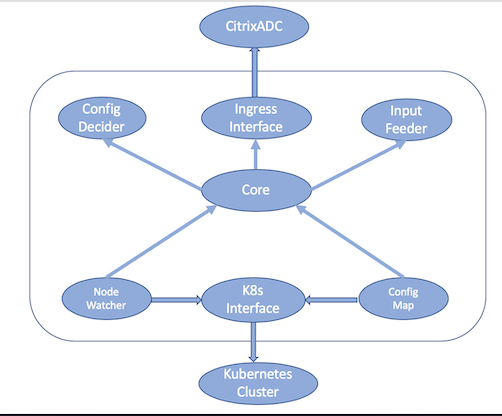Citrix k8s node controller is a micro service provided by Citrix that creates network between the Kubernetes cluster and ingress device.
Note: Citrix k8s node controller currently works only with flannel as the Container Network Interface (CNI). The scope of Citrix node controller can be extended to other CNI.
In Kubernetes environments, when you expose the services for external access through the Ingress device, to route the traffic into the cluster, you need to appropriately configure the network between the Kubernetes nodes and the Ingress device. Configuring the network is challenging as the pods use private IP addresses based on the CNI framework. Without proper network configuration, the Ingress device cannot access these private IP addresses. Also, manually configuring the network to ensure such reachability is cumbersome in Kubernetes environments.
Citrix provides a microservice called as Citrix k8s node controller that you can use to create the network between the cluster and the Ingress device.
The following diagram provides the high-level architecture of the Citrix k8s node controller:
The are the main components of the Citrix k8s node controller:
Ingress Interface
The Ingress interface component is responsible for the interaction with Citrix ADC through NITRO REST API. It maintains the NITRO sessions and invokes it when required.K8s Interface
This K8s Interface component interacts with the Kube API server through K8s Go client. It ensures the availability of the client and maintains a healthy client session.Node Watcher
The Node Watcher component monitors the node events through K8s interface. It responds to the node events such as node addition, deletion, or modification with its callback functions.Input Feeder
The Input Feeder component provides inputs to the config decider. Some of the inputs are auto detected and the rest are taken from the Citrix k8s node controller deployment YAML file.Config Decider
The Config Decider component takes inputs from both the node watcher and the input feeder. Using the inputs it decides the best network automation required between the cluster and Citrix ADC.Core
The Core component interacts with the node watcher and updates the corresponding config engine. It is responsible for starting the best config engine for the corresponding cluster.Config Maps
The Config Maps component controls the Citrix k8s node controller. It allows you to define Citrix k8s node controller to automatically create, apply, and delete routing configuration on Citrix ADC.Citrix k8s node controller monitors the node events and establishes a route between the node to Citrix ADC using VXLAN. Citrix k8s node controller adds route on the Citrix ADC when a new node joins to the cluster. Similarly when a node leaves the cluster, Citrix k8s node controller removes the associated route from the Citrix ADC. Citrix k8s node controller uses VXLAN overlay between the Kubernetes cluster and Citrix ADC for service routing.
Citrix k8s node controller can be used in the following two ways:
- In cluster Citrix k8s node controller configuration. In this configuration, the Citrix k8s node controller is run as microservice.
- Out of the cluster Citrix k8s node controller configuration. In this configuration, the Citrix k8s node controller is run as a process.
Important: Citrix recommends that you use In cluster configuration for production. And, use the Out of cluster configuration for easy development.
Before you deploy the citrix-k8s-node-controller` package, ensure that you have installed Go binary for running MIC.
Perform the following:
-
Download or clone the
citrix-k8s-node-controllerpackage. -
Navigate to the build directory and start the
citrix-k8s-node-controllerusing the following command:make run -
Deploy the config map using the following command:
kubectl apply -f https://raw.githubusercontent.com/citrix/citrix-k8s-node-controller/master/deploy/config_map.yaml
Refer the deployment page for running Citrix k8s node controller as a microservice inside the Kubernetes cluster.
For questions and support the following channels are available:
Describe the Issue in Details, Collects the logs and Use the discussion forum to raise the issue.
This project adheres to the Kubernetes Community Code of Conduct. By participating in this project you agree to abide by its terms.


